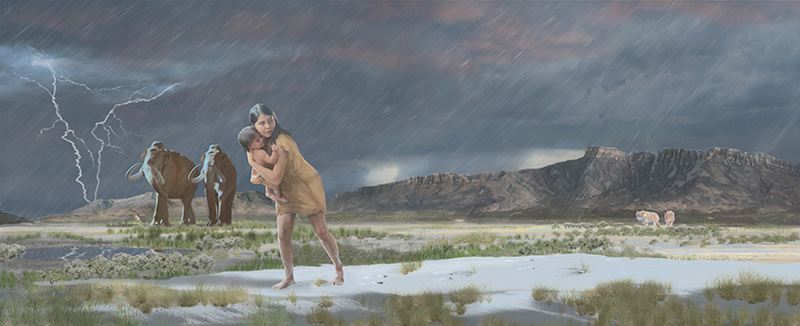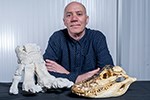RVC researcher joins collaborative international project investigating pre-historic fossil footprints
Research undertaken by an international team of researchers from Bournemouth University, the National Park Service USA, Cornell University, with assistance from Dr Ashleigh Wiseman from the °ÄĂĹÁůşĎ˛ĘąćÂÉÂŰĚł (RVC), has uncovered the longest known fossil human trackway in the world, revealing a fascinating episode of prehistoric humanity in the process.
Co-author of the research, Dr Ashleigh Wiseman, Postdoctoral Researcher in Biomechanics at the RVC, assisted in data analysis and data contextualisation of the fossil tracks, helping to understand how a prehistoric human moved across the Playa during the Late Pleistocene and determining whether or not this trackmaker was carrying a small child, as evidenced by the occasional toddler-sized footprints found along the way.
She joined a team of interdisciplinary researchers from around the world to discover and investigate a long prehistoric human trackway from the Late Pleistocene age, dated to before 13,000 years ago. The trackway was discovered at White Sands National Park in New Mexico, USA.
The small, toddler-sized footprints along the way indicate that a toddler was carried over a distance of 1.5km and periodically placed on the ground. The findings give a hauntingly vivid picture of a prehistoric episode, in which a child - perhaps two years old or slightly younger – is forced on a long journey in hostile surroundings.

The findings also show Colombian mammoth footprints cross-cutting with the trackways, indicating mammoth and humans co-existed in the same area, as well as tracks of mammoths, giant sloths, sabre-toothed cats, dire wolves, bison, and camels. This is a particularly significant discovery as it suggests a degree of human and megafauna (meaning large animals) interactions in the Late Pleistocene in the prehistoric American Southwest.
Dr Ashleigh Wiseman, Postdoctoral Researcher in Biomechanics at the °ÄĂĹÁůşĎ˛ĘąćÂÉÂŰĚł, said: “It was a pleasure to join colleagues from around the world in uncovering this incredible trackway. The discovery gives us an eerily vivid sense of a real episode that happened in prehistoric history, at a time when humans and mammoths existed on the same planet.
I would like to thank my colleagues from Bournemouth University, the National Park Service USA and Cornell University for making this such a fascinating project to work on. Projects like this demonstrate how a collaborative and interdisciplinary approach to research projects can have such an impact on our knowledge and learning.”
Research reference
Read the full paper:
For more information see:
Notes to Editors
For more information please contact:
- Jasmin De Vivo (Jasmin.DeVivo@plmr.co.uk or rvc@plmr.co.uk
- Press Line: 0800 368 9520
About the RVC
- The °ÄĂĹÁůşĎ˛ĘąćÂÉÂŰĚł (RVC) is the UK's largest and longest established independent veterinary school and is a Member Institution of the University of London. It was the first in the world to hold full accreditation from AVMA, EAEVE, RCVS and AVBC.
- The RVC is the top veterinary school in the UK and Europe, and ranked as the world’s second highest veterinary school in the QS World University Rankings by subject, 2020.
- The RVC offers undergraduate and postgraduate programmes in veterinary medicine, veterinary nursing and biological sciences.
- In 2017, the RVC received a Gold award from the Teaching Excellence Framework (TEF) – the highest rating a university can receive.
- A research led institution with 79% of its research rated as internationally excellent or world class in the Research Excellence Framework 2014.
- The RVC provides animal owners and the veterinary profession with access to expert veterinary care and advice through its teaching hospitals and first opinion practices in London and Hertfordshire.
You may also be interested in:
-
RVC’s Professor John Hutchinson elected Fellow of prestigious Royal Society
John Hutchinson, Professor of Evolutionary Biomechanics at the °ÄĂĹÁůşĎ˛ĘąćÂÉÂŰĚł (RVC), has …

